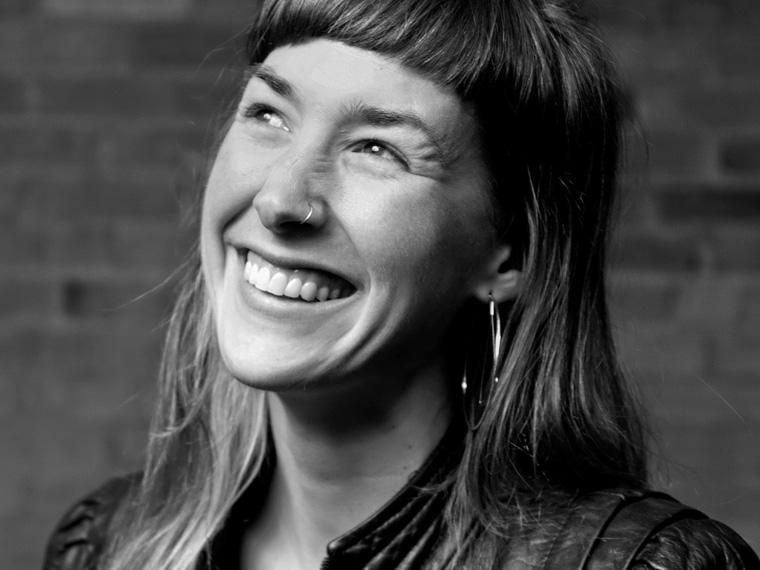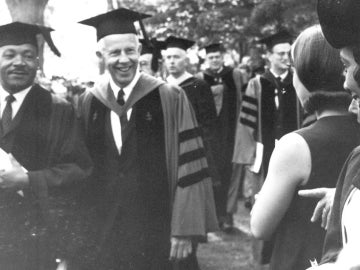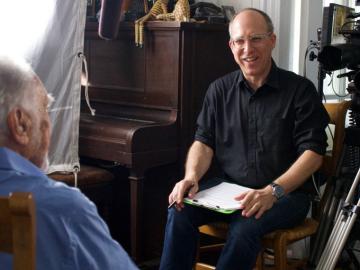Oberlin Alumni Magazine
The Historian
Katie Thornton '15's award-winning podcasts and magazine features reflect her love for radio, history, and archival research.
May 28, 2025
Eloise Rich ’26

Photo credit: Courtesy of Katie Thornton
In fall 2020, Katie Thornton ’15 was driving in northern Minnesota as part of a reporting project for National Geographic. As she flipped through the radio, only one station came in, airing a conservative Christian show called Focus on the Family. Thornton kept the show on, in part to have a voice to accompany her on the drive. But it piqued her interest.
“I started to envision this alternate reality in which I lived in that area, and this was the one radio station that I had access to,” Thornton explains. “No matter what I thought of the content, I knew I would be listening. I started to wonder how much of the very conservative and right-wing dominance on talk radio is consumer preference and consumer choice versus political and economic strategy.”
These thoughts, coupled with her penchant for serial narratives, resulted in Thornton’s historical deep-dive podcast the Divided Dial for WNYC’s On the Media. The six-episode series investigated the rise and present dominance of conservative ideology on talk radio—think Rush Limbaugh—and won a 2023 Peabody Award.
Thornton has always loved radio, especially the way it cuts across demographics and creates aural experiences for listeners. While at Oberlin, she had a radio show on WOBC each year and served as operations manager her first year and program director during her fourth year.
But Thornton, who majored in history at Oberlin, has also always loved digging into archives. After graduating, she “started to throw job ideas at the wall to see what would stick,” she says. “I approached a lot of places that I thought could have a public history component to their organization and asked if they would let me design a job and do it.”
Much to her surprise, a cemetery in town was game and she became its historian. This job eventually led to her earning a 2018–19 Fulbright-National Geographic Digital Storytelling Fellowship, where she traveled to England and Singapore and researched the relationship between death practices and modes of remembering the dead in an increasingly digitally connected world.
Today, Thornton balances her audio journalism with long-form print work for publications such as the Guardian, the Atlantic, and Rolling Stone. “I love working in both print and audio because I get to choose which format is right for which story,” she says. “Oftentimes there can be a sense within the industry that you have your beat, and you have your format, and that’s where you stay. People of all ages right now want in-depth news—they want to be informed.
“The journalism world can learn something from the broader podcasting world in that there are ways that we need to engage people if we want them to keep caring,” Thornton continues. “In the same way that you would learn in an introduction to creative writing class, you have to engage the senses [and] activate people’s memories.”
When writing, Thornton keeps in mind advice she received from Professor of History and Comparative American Studies Pablo Mitchell as she did her Oberlin history capstone: Emphasize prose. “He was basically like, ‘This is really interesting history, and you’re kind of treating it like it’s boring,’” Thornton recalls. “That’s something I think about often… to not be afraid to get a little bit colorful [and] to have fun with what you’ve learned.”
Thornton is currently teaching a course at Macalester College called Podcasting: Creative and Practical Elements of Audio Nonfiction and working on the second season of the Divided Dial. Released in May, it focuses on shortwave radio, “the strange cousin of AM and FM talk radio,” she says. “It doesn’t require a local transmitter; it’s really difficult to jam; and it penetrates obstacles and terrain pretty well, so it’s almost tailor-made for propaganda.
“The series is looking at the way that this medium went from a utopian communication tool to a propaganda tool for the American right and the militia movement, and then its very strange, continued existence today, which is this invisible world that’s coursing all around us at all times. Once you tap into it, there’s a whole lot to learn.”
This story originally appeared in the Spring 2025 issue of the Oberlin Alumni Magazine as part of the feature "A Pipeline to Podcasts."
You may also like…
Tied Together in a Single Garment of Destiny
Cooking Up a Cinematic Gem
Coming Full Circle


